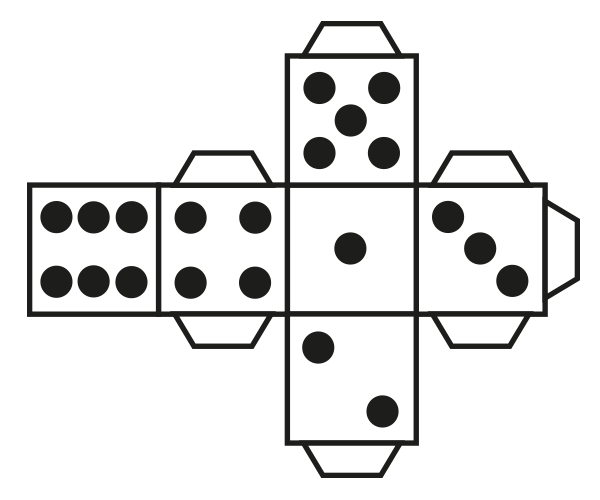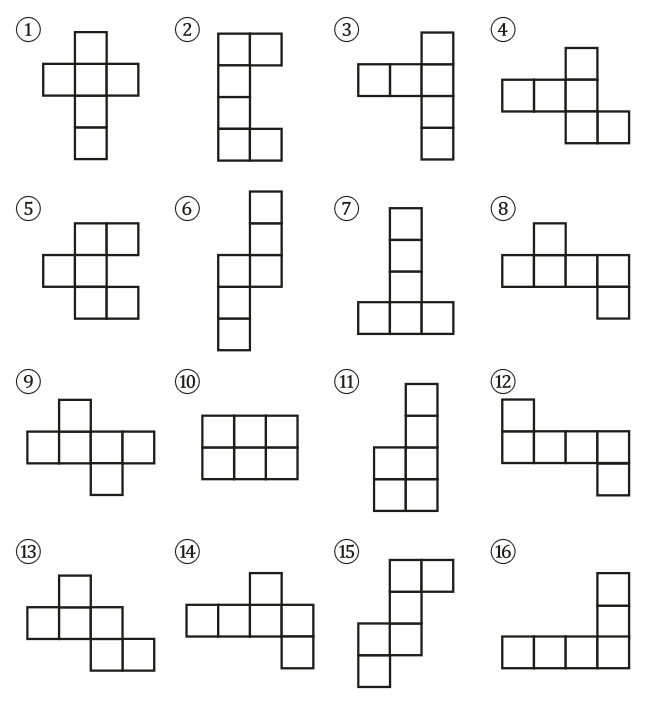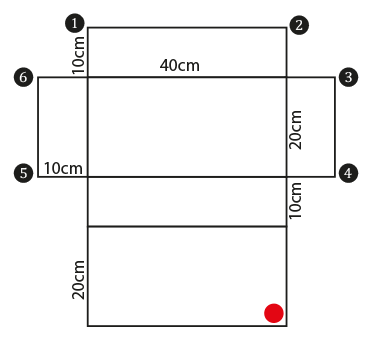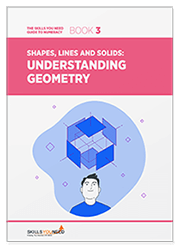Net Diagrams of 3D Shapes
See also: Three-dimensional ShapesIn our page on three-dimensional shapes, we introduced 3D shapes called polyhedrons, which have multiple flat surfaces (faces) made up of 2D polygons, joined by straight edges and sharp corners (vertices).
A useful property of these solid shapes is that they can be described visually in two dimensions by a shape net.
A net in this context is nothing like a fishing net or a basketball net! It is simply a 2D picture of what the 3D shape would look like if all its sides were folded out flat. Imagine a cardboard box that has been opened out, for example.
A 2D net can be folded up to make the 3D shape.
Nets of Cubes and Cuboids
In the diagram below, you can see the familiar markings of a dice, but rather than being the 3D cube that you would expect, it is a flat 2D representation of the dice. You could cut this out and glue it together to make the cube :

The six separate squares with the familiar dots of the dice on are the shape net of the cube. The little tabs around the edges are there so that you can glue the dice together.
Shape nets for cubes – there isn’t just one answer
Cube nets are some of the simplest to visualise and it’s a fun test of your spatial skills to see how many you can create. In fact, there are 11 shape nets that make a cube.
The diagram below shows 16 different arrangements of 6 squares that all look like they could be cube nets, but 6 of them are not. Can you work out which are valid nets of a cube?

The answer is that 1, 4, 6, 7, 8, 9, 12, 13, 14 and 15 are all valid nets of a cube.
2, 3, 5, 10, 11 and 16 cannot make a cube and they are non-nets. There is one valid net missing…. can you work it out?
This is quite tricky...
Now that you have started to exercise your spatial skills with regular cubes, the shape nets of a cuboid should be easier to understand.
A cuboid is similar to a cube, but some or all of its sides may be rectangular. The nets therefore have the same sort of characteristics as those for a cube, but they appear quite different.
Here is a net of a rectangular cuboid with side lengths 10cm, 20cm and 40cm.

In the cuboid net above, look for the vertex (corner) marked with the red dot. Using your spatial skills again, can you work out which other vertices, labelled 1 – 6, will join up with the red dot, when the cuboid is in its 3D form?
Nets can tell us more….
Now that we know the dimensions of the net, we can find out other properties of this solid, such as its volume and surface area.
The volume of a cuboid is calculated from the product of its length, width and height:
Length × Width × Height = 40 × 20 × 10 = 192
The volume of this cuboid is therefore 8,000 cm3 or 8 litres.
The surface area is the total area of all six sides added together.
We have two sides each of 20 × 40cm, 10 × 20cm and 10 × 40cm.
2 × 20 × 40 = 1,600
2 × 10 × 20 = 200
and 2 × 10 × 40 = 800
16 + 200 + 800 = 2,800
The cuboid therefore has a surface area of 2,800 cm2 or 0.28m2
Nets of Prisms, Pyramids and other Polygons
As with the cube example above, any 3D shape can have multiple nets, not just one, but here are some 3D shapes with examples of just one of their nets. See if you can work out some more.

Nets of Curved Solids
All of the examples above have concentrated on flat-sided polygons. Curved shapes can have nets too. They are simpler to visualise and construct if the solid has at least one flat surface. Here are some examples.

Sphere or Globe
A sphere has no flat surfaces, it is a continuous curve.

The creation of a flat 2D net of the globe was a problem for cartographers (map-makers) for centuries. When we look at the net of a sphere, we can see why it was difficult for cartographers to use it. Nevertheless, maps of the world have been produced this way:

Imagine you have an orange and you cut it into segments. When you have eaten the flesh, you are left with the pieces of skin. If you were to line them up, then they would look similar to the net of a sphere.
However, there is a flaw with this approach. No matter how many segments, each one will still have a flat surface.
Looking again at your pieces of orange skin, they not only curve top to bottom, but they curve side to side as well, unlike the page, which can only curve in one direction. This is called double curvature. It is therefore impossible to make a completely accurate 2D net of a 3D shape with double curvature. Even if there were 100 segments in the net above, it would still be an approximation.
Cartographers eventually overcame this problem by making maps based on a cylinder, called a projection. This is also an approximation, but it incorporates a distorted view of the surface of the globe that allows distances to be measured accurately on a flat map. For more on this, see our page on polar, cylindrical and spherical coordinate systems.
Conclusion: Why do we need nets at all?
Being able to understand how a three-dimensional shape is made up of two-dimensional components is not only a useful skill if you need to construct a box, but is also vitally important in any aspect of 3D design.
Engineers and designers use complex and powerful computer aided design (CAD) packages to help design everything from flat-packed furniture to the world’s largest cruise ships.
The important spatial skills that you build from a basic understanding of shape nets can therefore develop further into other more challenging design applications.
Further Reading from Skills You Need
Understanding Geometry
Part of The Skills You Need Guide to Numeracy
This eBook covers the basics of geometry and looks at the properties of shapes, lines and solids. These concepts are built up through the book, with worked examples and opportunities for you to practise your new skills.
Whether you want to brush up on your basics, or help your children with their learning, this is the book for you.



